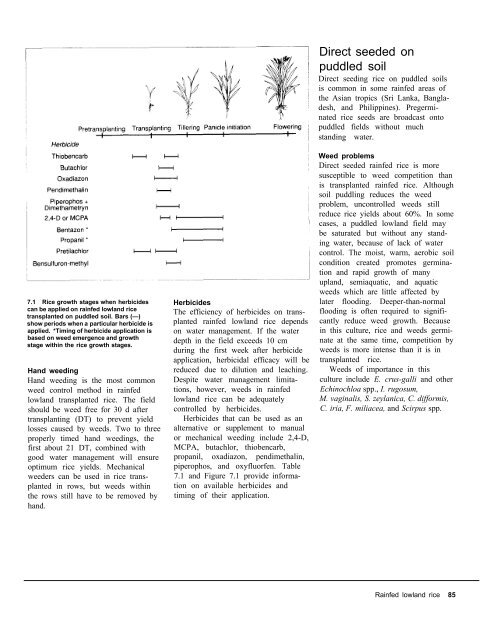A handbbok on Weed Control in Rice.pdf
A handbbok on Weed Control in Rice.pdf
A handbbok on Weed Control in Rice.pdf
Create successful ePaper yourself
Turn your PDF publications into a flip-book with our unique Google optimized e-Paper software.
7.1 <strong>Rice</strong> growth stages when herbicides<br />
can be applied <strong>on</strong> ra<strong>in</strong>fed lowland rice<br />
transplanted <strong>on</strong> puddled soil. Bars (—)<br />
show periods when a particular herbicide is<br />
applied. *Tim<strong>in</strong>g of herbicide applicati<strong>on</strong> is<br />
based <strong>on</strong> weed emergence and growth<br />
stage with<strong>in</strong> the rice growth stages.<br />
Hand weed<strong>in</strong>g<br />
Hand weed<strong>in</strong>g is the most comm<strong>on</strong><br />
weed c<strong>on</strong>trol method <strong>in</strong> ra<strong>in</strong>fed<br />
lowland transplanted rice. The field<br />
should be weed free for 30 d after<br />
transplant<strong>in</strong>g (DT) to prevent yield<br />
losses caused by weeds. Two to three<br />
properly timed hand weed<strong>in</strong>gs, the<br />
first about 21 DT, comb<strong>in</strong>ed with<br />
good water management will ensure<br />
optimum rice yields. Mechanical<br />
weeders can be used <strong>in</strong> rice trans-<br />
planted <strong>in</strong> rows, but weeds with<strong>in</strong><br />
the rows still have to be removed by<br />
hand.<br />
Herbicides<br />
The efficiency of herbicides <strong>on</strong> trans-<br />
planted ra<strong>in</strong>fed lowland rice depends<br />
<strong>on</strong> water management. If the water<br />
depth <strong>in</strong> the field exceeds 10 cm<br />
dur<strong>in</strong>g the first week after herbicide<br />
applicati<strong>on</strong>, herbicidal efficacy will be<br />
reduced due to diluti<strong>on</strong> and leach<strong>in</strong>g.<br />
Despite water management limita-<br />
ti<strong>on</strong>s, however, weeds <strong>in</strong> ra<strong>in</strong>fed<br />
lowland rice can be adequately<br />
c<strong>on</strong>trolled by herbicides.<br />
Herbicides that can be used as an<br />
alternative or supplement to manual<br />
or mechanical weed<strong>in</strong>g <strong>in</strong>clude 2,4-D,<br />
MCPA, butachlor, thiobencarb,<br />
propanil, oxadiaz<strong>on</strong>, pendimethal<strong>in</strong>,<br />
piperophos, and oxyfluorfen. Table<br />
7.1 and Figure 7.1 provide <strong>in</strong>forma-<br />
ti<strong>on</strong> <strong>on</strong> available herbicides and<br />
tim<strong>in</strong>g of their applicati<strong>on</strong>.<br />
Direct seeded <strong>on</strong><br />
puddled soil<br />
Direct seed<strong>in</strong>g rice <strong>on</strong> puddled soils<br />
is comm<strong>on</strong> <strong>in</strong> some ra<strong>in</strong>fed areas of<br />
the Asian tropics (Sri Lanka, Bangla-<br />
desh, and Philipp<strong>in</strong>es). Pregermi-<br />
nated rice seeds are broadcast <strong>on</strong>to<br />
puddled fields without much<br />
stand<strong>in</strong>g water.<br />
<strong>Weed</strong> problems<br />
Direct seeded ra<strong>in</strong>fed rice is more<br />
susceptible to weed competiti<strong>on</strong> than<br />
is transplanted ra<strong>in</strong>fed rice. Although<br />
soil puddl<strong>in</strong>g reduces the weed<br />
problem, unc<strong>on</strong>trolled weeds still<br />
reduce rice yields about 60%. In some<br />
cases, a puddled lowland field may<br />
be saturated but without any stand-<br />
<strong>in</strong>g water, because of lack of water<br />
c<strong>on</strong>trol. The moist, warm, aerobic soil<br />
c<strong>on</strong>diti<strong>on</strong> created promotes germ<strong>in</strong>a-<br />
ti<strong>on</strong> and rapid growth of many<br />
upland, semiaquatic, and aquatic<br />
weeds which are little affected by<br />
later flood<strong>in</strong>g. Deeper-than-normal<br />
flood<strong>in</strong>g is often required to signifi-<br />
cantly reduce weed growth. Because<br />
<strong>in</strong> this culture, rice and weeds germi-<br />
nate at the same time, competiti<strong>on</strong> by<br />
weeds is more <strong>in</strong>tense than it is <strong>in</strong><br />
transplanted rice.<br />
<strong>Weed</strong>s of importance <strong>in</strong> this<br />
culture <strong>in</strong>clude E. crus-galli and other<br />
Ech<strong>in</strong>ochloa spp., I. rugosum,<br />
M. vag<strong>in</strong>alis, S. zeylanica, C. difformis,<br />
C. iria, F. miliacea, and Scirpus spp.<br />
Ra<strong>in</strong>fed lowland rice 85











